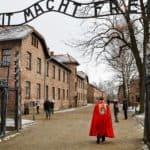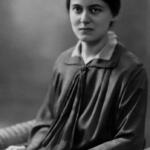Auschwitz, Poland: St. Maximillian Kolbe and Saint Teresa Benedicta of the Cross (Edith Stein)
About the camp at Auschwitz:

Nowhere is man’s inhumanity to man more starkly presented than at the concentration camp at Auschwitz. It is almost incomprehensible, and although some tours visit here as well as independent travelers, there are some for whom the experience is so depressing that they choose to pass it up. The scope of the cruelty is certainly something we prefer not to dwell on……although there are those who say we must never forget lest we run the danger of repeating it.
The vast majority of those who died here were Jews; however, there were also many victims of other faiths including hundreds of Catholic priests, religious and lay members.
About Saint Maximilian Kolbe:
One of the many priests murdered here is Maximillian Kolbe. Born in Poland in 1894, he founded the Immaculata Movement prior to his ordination to the priesthood as a Franciscan. The movement became one of the largest with over 800 members. He was briefly imprisoned by the Nazis after the start of World War II in 1939, then released, and then again imprisoned again in 1941, this time at Auschwitz.
In John 15:13, Jesus tells us: “no one has greater love than this, to lay down one’s life for one’s friends”. Maximilian Kolbe lived this out.
In July of 1941 a prisoner escaped from the camp an in reprisal ten prisoners were selected at random to be starved to death. Maximilian was not one of those ten; however, he volunteered to take the place of one of the men, a young father named Franciszek Gajowniczek who had begged for his life to be spared for the sake of his wife and young children.
Thrown into a starvation bunker all ten men died and despite their cruel deaths, reports of Saint Maximilian Kolbe leading the men in prayers and song abounded. Saint Maximilian Kolbe was the last of the men to die–in fact after 2-3 weeks the Nazis found him still alive and gave him a lethal injection.
You will find his cell on display here: in the center you will see a large white candle — a gift of the Polish-born Saint John Paul II.
He was canonized by Pope John Paul II in 1982. Among those attending his Canonization was Franciszek Gajowniczek, the man whose place he took in the starvation bunker.
He is considered the Patron Saint of the pro-life movement, prisoners, journalists and the chemically addicted.
His feast day is celebrated on August 14.
There is a National Shrine to St. Maximilian Kolbe in the U.S. in Libertyville, Illinois.
About Edith Stein:
 Also among the thousands of Catholics killed in the camps was Edith Stein , a convert from the Jewish faith to Catholicism. Born in 1891 to a devout Jewish family, by her teenage years she had become an atheist (how often do we see that in our own lives?). She eventually read the works of Saint Teresa of Avila, which led to her converting to the Catholic faith. After her conversion she became a Discalced Carmelite in Cologne, Germany under the name of Teresa Benedicta of the Cross. In 1938, she and her sister Rosa, by then also a convert and an extern sister (tertiaries of the Order, who would handle the community′s needs outside the monastery), were sent to the Carmelite monastery in Echt, Netherlands, for their safety.
Also among the thousands of Catholics killed in the camps was Edith Stein , a convert from the Jewish faith to Catholicism. Born in 1891 to a devout Jewish family, by her teenage years she had become an atheist (how often do we see that in our own lives?). She eventually read the works of Saint Teresa of Avila, which led to her converting to the Catholic faith. After her conversion she became a Discalced Carmelite in Cologne, Germany under the name of Teresa Benedicta of the Cross. In 1938, she and her sister Rosa, by then also a convert and an extern sister (tertiaries of the Order, who would handle the community′s needs outside the monastery), were sent to the Carmelite monastery in Echt, Netherlands, for their safety.
For a time, the Nazis did not aggressively seek out those in Belgium who had converted from Judaism. She was sheltered in Belgium for a while, but after the Dutch Bishops’ Conference had a public statement read in all the churches of the nation on July 20, 1942 condemning Nazi racism, all Jewish converts were rounded up and sent to Auschwitz. Edith Stein was among them, and was executed shortly after her arrival there.
For those who criticize the Church for not speaking out more forcefully against the Nazis, here is an example of the result. Whether it would have been better to speak out or not, is up to you to decide.
Edith Stein was canonized October 11, 1998 and is now known as Saint Teresa Benedicta of the Cross. Her feast day is celebrated on August 9, the day it is assumed that she was executed.
At her beatification on May 1, 1987 Pope Saint John Paul II said about her:
“We bow down before the testimony of the life and death of Edith Stein, an outstanding daughter of Israel and at the same time a daughter of the Carmelite Order, Sister Teresa Benedicta of the Cross, a personality who united within her rich life a dramatic synthesis of our century. It was the synthesis of a history full of deep wounds that are still hurting . . . and also the synthesis of the full truth about man. All this came together in a single heart that remained restless and unfulfilled until it finally found rest in God.”
You can find a great selection of Blessed Edith Stein medals and more here in our online store.
About touring Auschwitz:
If you are touring the camp you can see the cell number 18 where Saint Maximillian died along with the nine others who died with him him.
As mentioned earlier, it makes for a rather heavy day and some people on organized tours prefer to avoid visiting here, but many feel it is necessary that we not forget the past.
If you do visit, you might want try to put some lighter activities later in your day as well to help offset the somber reality of the visit.
Traveling to Auschwitz:
Many tour groups going to Poland include this as a stop, and of course it has been visited by many famous dignitaries such as Pope Benedict XVI. The camp is about one hour outside of Krakow if you are traveling independently. And there are tours originating from Krakow as well.
Address: Więźniów Oświęcimia 20, 32-603 Oświęcim, Poland
GPS coordinates: 19.20363 E, 50.0266 N
Tel: +48 338448099
e-mail: reservation.office@auschwitz.org
Click here for the official website of Auschwitz-Birkenau Museum.
Click here for information about a shrine to St. Maximilian Kolbe in the U.S.
Article sources:
1. Auschwitz-Birkenau Museum
2. Rev. J.J. Smith, Saint Maximilian Kolbe
3. New American Bible
4. Photo credit: Reuters, Shrine of St. Maximilian Kolbe
